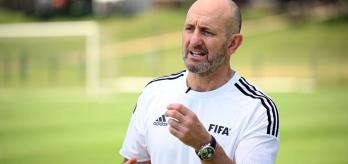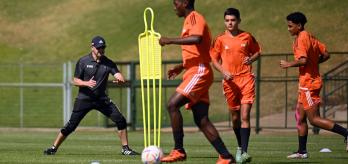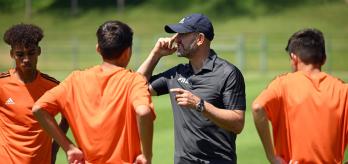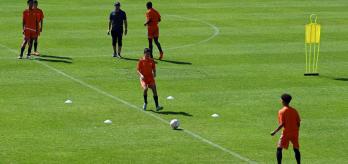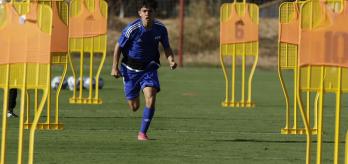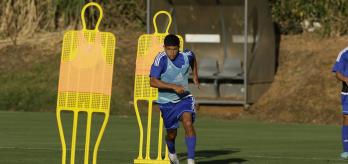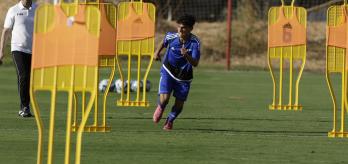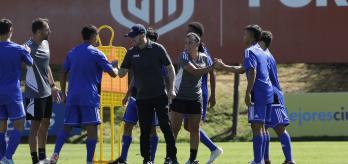While parts I and II focused on a single player assisted by static support players and a coach server, this session targets collective connectivity and technical interactions between a unit of players. Collective connectivity is an essential training aspect when preparing players to return from long term injuries. It prepares them for high-level football functionality and situations in which quick, fluid and dynamic pass-and-move interactions are required. The timing, weight and accuracy of their passes combined with collective movement at a high tempo are emphasised and repeated to provide the needed training stimulus for this period.
Training perspective
Functional coordination part III is appropriate as a one-off session for players recovering from a short-term injury or as a session to be repeated for those with a longer recovery plan. The drills are two to four minutes long and designed for a minimum of three players or three players assisted by a ball-serving player or coach server. All the players are continuously involved (to varying degrees) within the rotational sequences, with short recovery periods interspersed between the actions to regulate the overall intensity.
Emphasis and methodology
The drills impose a variety of scenarios with and without the ball, targeting functional coordination in spaces of between five and 20 metres with a focus on tempo and fluid technique. All the drills are technically balanced and designed with parity of movement. Footballing awareness should also be emphasised and encouraged during the drills. Overall, the methodology involves a loaded technical exposure with a level of intensity and distances that are appropriate for this phase. The drills provide a technical-physical stepping stone to the next transitional phase of returning from injury.
.variant615x346.jpg)
Overall objective
To provide a training stimulus aimed at sharpening the coordinative and awareness pathways of footballing technique following brief injury lay-offs and to reboot, recondition and adapt those same pathways following a longer spell on the sidelines. Specific emphasis is placed on collective coordination and passing within a unit of players.
Implementation
Aimed at all on-field practitioners responsible for helping players return from injury, the drills in this session form part of an overall training programme aimed at providing a variety of (technically biased) technical-physical training options and solutions for all phases of returning from injury. Practitioners can select individual drills or entire sessions to fit their overall training plans for players in their care.
The drills in this session can also be used for:
- small training groups of 3-5 players;
- technical recovery sessions from high-intensity workloads or match play;
- dedicated non-contact technique and passing quality; and
- technical-physical potentiation and warm-up.
Workload metrics
A simple table showing the duration of the drills, the number of sets and the work-to-rest ratios can be found here:
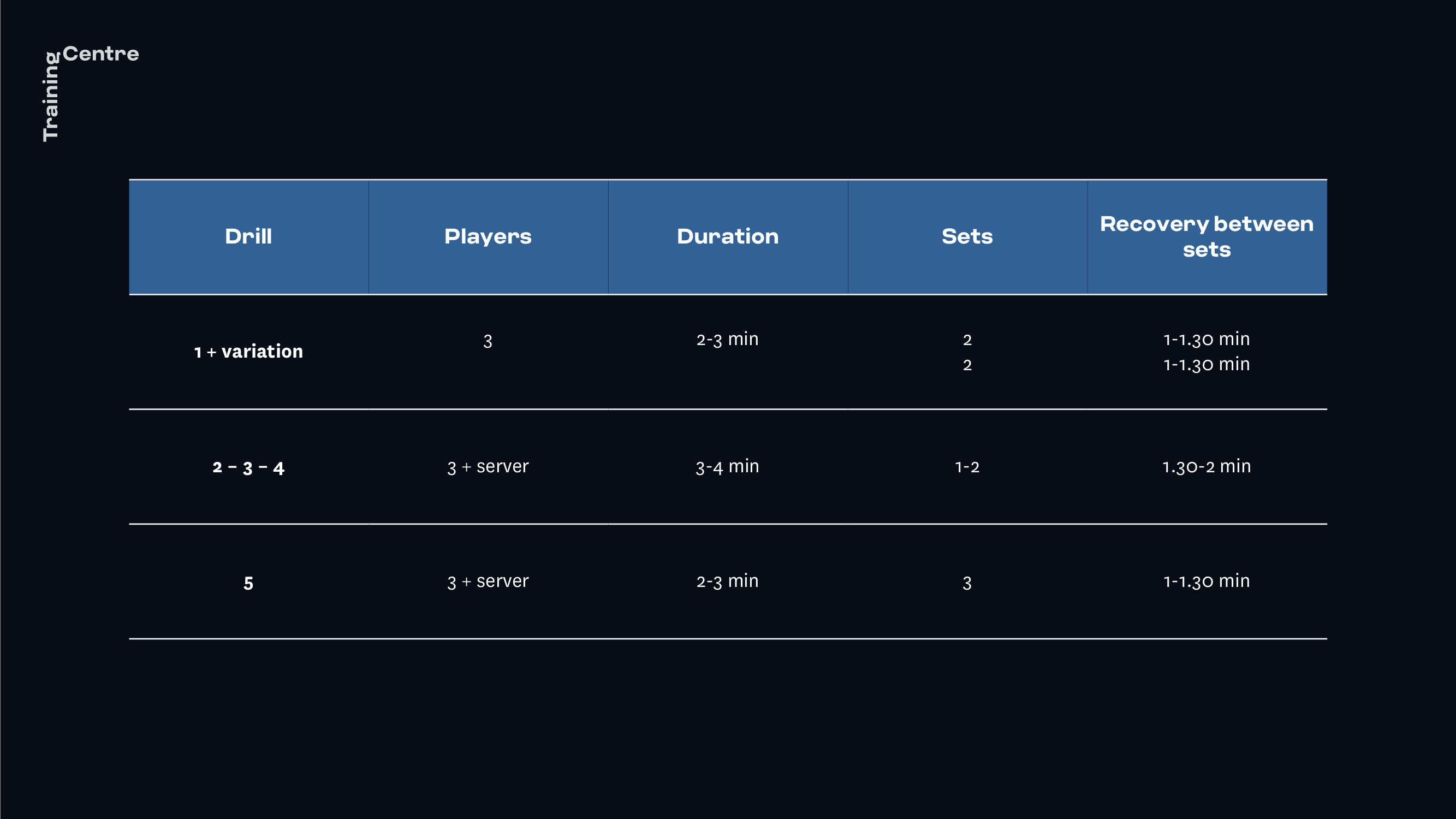
Set-up drill 1 only
Grid distances
-
Set up a 15x3m or 15x4m outer grid using four mannequins or poles (a+b).
-
Two sets
-
2-3 minutes, work-recovery intervals, dependent on the number of players
-
For technical balance, drill 1 requires clockwise and anti-clockwise rotations, including when the variation is introduced
-
Minimum of 2 working players + 1 ball-serving player
-
Maximum of 3 working players + 1 ball-serving player
-
Allow players a familiarisation period before starting the first set
-
Encourage players to use their left and right foot to pass and perform their technical movements
-
The duration of drills is to be calculated while the ball is in play; stop the watch if the rhythm of the drill is interrupted
Drill 1: One- and two-touch pass and move
-
Player 1 shifts the ball forwards and plays a straight pass wide of the mannequin gate for player 2
-
Player 2 plays a short, first-time return ball angled into the path of player 1, then moves quicky across the mannequin gate to receive a second pass. Player 1 plays an angled ball into the path of player 2 between the mannequins
-
Player 2 then shifts the ball beyond the other outer mannequin and plays a straight pass to player 3 at the opposite end of the grid so that the sequence can be repeated
-
Player 2 plays a short, first-time return ball angled into the path of player 1, then moves quicky across the mannequin gate to receive a second pass
-
Player 1 plays a first-time pass between the mannequin gate, angled into the path of player 2
-
Player 2 should try to play a first-time pass to player 3
-
After playing the straight pass, players should avoid getting too close to the player at the mannequin gate.
-
For technical balance, players should be encouraged to use their right foot when passing from the right side of the mannequin gate and their left foot when passing from the left side of the mannequin gate.
-
To reinforce good awareness, players should be encouraged to look up before playing the pass into the path of the next player.
Set-up for drills 2-5
Grid distances
-
Set up a 15x15m outer grid using four flat discs or cones (a+b)
-
Set up a 15x4m inner grid using four mannequins or poles (c+d)
-
One to two sets
-
3-4 minutes, work-recovery intervals, dependent on the number of players
-
Drill 5 requires three sets of 2-3 minutes each if all players are required to undertake the loaded technical exposure of player 1
-
All drills are technically balanced
-
Minimum of 3 working players + 1 ball-serving player
-
Maximum of 4 working players + 1 ball-serving player
-
Allow players a familiarisation period before starting the first set
-
Encourage players to use their left and right foot to pass and perform their technical movements
-
The duration of drills is to be calculated while the ball is in play; stop the watch if the rhythm of the drill is interrupted
Drill 2: Accelerate into space to instigate a first-touch passing combination
-
Player 1 (the working player) runs from the midpoint of the grid to the mannequin gates at one end to receive a diagonal pass from the ball server
-
Player 1 then instigates a first-touch passing combination with player 3 (the supporting player) and receives passes on either side of the middle mannequin
-
Player 1 plays a diagonal ball to the ball server so that the sequence can be repeated from the opposite end of the grid
-
Player 3 runs quickly to the mannequin gates at the opposite end of the grid and becomes the next working player
-
Players should avoid getting too close to each other at the mannequin gates.
-
For technical balance, players should be encouraged to use their right foot when passing from the right side of the mannequin gates and their left foot when passing from the left side the mannequin gates.
Drill 3: Pass and move into space, turn and find the diagonal run
-
Player 1 plays a short, diagonal one-two with player 2, followed by a straight pass to the ball server and a run towards the opposite end of the grid to receive the return pass
-
After shifting the ball forwards, player 1 slots a long diagonal pass into the path of player 2 at the other end of the grid
-
Player 2 latches onto the ball with a short diagonal pass into the path of the next player 1
-
The sequence is then repeated in the opposite direction across the grid
-
To increase the tempo of the drill, the short one-two with player 2 is omitted from the sequence
-
Player 1 should step in and meet the pass from player 2.
-
Player 2 should anticipate player 1’s trajectory and play the ball ahead of them so they can run onto it.
-
For technical balance, player 1 should be encouraged to use their left and right foot to play the long diagonal passes.
-
When playing from the right side of the grid, player 2 should be encouraged to use their right foot for the short diagonal pass to the next player 1. The opposite applies when playing from the left side.
-
To reinforce good awareness, player 1 should scan towards player 2 before receiving the return pass from the ball server.
-
Player 1 should get their head up before playing the long diagonal pass into the path of player 2.
-
Player 2 should scan towards player 1 to time their little push beyond the mannequin gates with the pass from player 1.
Drill 4: Diagonal ball into the space to meet the run in behind
-
There is more space between the mannequin gates in drill 4 than in drills 2 and 3 (see set-up)
-
Drill 4 starts with a short diagonal pass from player 1 towards the outer mannequin gate for player 2
-
Player 1 then makes a surging run to the mannequin gate at the opposite end of the grid
-
Meanwhile, player 2 shifts the ball across the mannequin gate and plays a one-two with the ball server
-
Player 2 latches onto the return ball from the server and guides a long diagonal pass into the space between the mannequins to meet the run in behind from player 1 at the opposite end of the grid
-
Player 1 slots an angled pass back to the player at the starting position
-
Player 1 now becomes player 2, and the sequence is repeated using the other end of the grid
-
After slotting the diagonal pass back to the player at the starting position, the new player 2 should move quickly away on the half turn to wide of the mannequin gates to prepare to receive the return ball.
-
For technical balance, player 2 should be encouraged to meet the ball with a first-time right-footed pass when playing the diagonal ball from left to right across the grid. The opposite applies when playing the diagonal ball from right to left.
-
To reinforce good awareness, player 2 should scan towards the ball server before receiving the return pass from player 1.
-
Player 2 should scan across to player 1 at the opposite mannequin gates before receiving the return pass from the ball server, then get their head up before playing the long diagonal pass into the path of player 1.
-
Player 1 should scan towards player 2 to time their little push beyond the mannequin gates with the pass from player 2.
Drill 5: Play across the line and find the movement between the gates
-
Player 2 starts the rotation from the mannequin gates at one end of the grid with a diagonal pass into the central area for player 1
-
Player 1 switches direction and plays the ball to player 3 at the opposite mannequin gates
-
After receiving a first-time return pass, player 1 switches direction for a second time and slots a pass between the gates to connect with the short run in behind the middle mannequin from player 2
-
Player 2 continues the rotation with a diagonal pass into the opposite central area for the ball server
-
The server then turns and plays the ball out to player 3
-
The rotational sequence is then repeated, with the first pass being played by player 3
-
With each rotation, player 1 alternates playing the penetrating passes between the gates for players 2 and 3
-
Players 2 and 3 therefore alternate making short runs in behind the middle mannequin
-
Player 1 should work across the line of play to receive the passes from players 2 and 3, then shift the ball quickly to play the angled through-ball.
-
For technical balance, player 1 should be encouraged to use their left and right foot to play the passes between the mannequin gates.
-
To reinforce good awareness, player 1 should scan towards player 2 or 3 before receiving the ball.
-
Player 1 should get their head up before playing the through-ball into the path of player 2 or 3.
-
Players 2 and 3 should scan towards player 1 to time their little push beyond the mannequin gates with the pass from player 1.









